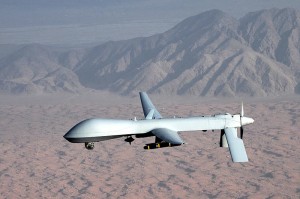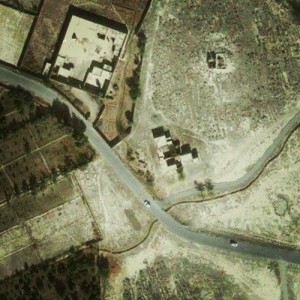Every morning I leave home early, making sure to snatch (steal?) one of the free copies of The New York Times from COM before they’re all gone. I scan the headlines as I dodge traffic across Commonwealth Avenue, and last Monday one stood out in particular. In “Election Spurred a Move to Codify U.S. Drone Policy,” the Times reported that, “facing the possibility that President Obama might not win a second term, his administration accelerated work in the weeks before the election to develop explicit rules for the targeted killing of terrorists by unmanned drones, so that a new president would inherit clear standards and procedures, according to two administration officials.” Drones were discussed briefly during the third presidential debate on foreign policy, but despite the candidate’s agreement on utilization of drones for military strikes, “Mr. Obama did not want to leave an ‘amorphous’ program to his successor.” Even now, after winning its reelection:
the administration is still pushing to make the rules formal and resolve internal uncertainty and disagreement about exactly when lethal action is justified…. The president expressed wariness of the powerful temptation drones pose to policy makers. “There’s a remoteness to it that makes it tempting to think that somehow we can, without any mess on our hands, solve vexing security problems.”
Drones are one of the most fascinating technologies at work today. An argument for the future having arrived, these machines can be airborne for almost 20 hours, fly as high as 50,000 feet, and be controlled from anywhere in the world. The utility of drones is continually reiterated by their successful military applications. And like Jeeps and cargo pants, they are slowly migrating from the battlefield and into our everyday life. Drones are not only remote terrorist-killing robots; drones are an increasingly popular surveillance tool. Remote and inconspicuous, they are well suited for their job. But these same traits make them incredibly unnerving.

The Los Angeles Times reported at this time last year how state police in North Dakota “made the first known arrests of U.S. citizens with help from a Predator, the spy drone that has helped revolutionize modern warfare.” Finding themselves in a stalemate with armed cattle-thieves, the police borrowed a drone from the Federal Customs and Border Protection Agency, who use (unarmed) predator drones to patrol the U.S.-Canadian border. The police used the high-resolution cameras, heat sensors and sophisticated radar on the border protection drones to find the thieves and ensure they were unarmed before the next confrontation, where police apprehended the men.
Private citizens are even putting drones to use. Not as large as the Predator drones operated by governments, these drones are nicknamed “quadcopters” (no affiliation to this website…yet) and can be operated by a smartphone. Last year, Occupy Wall Street used a quadcopter to document their interactions with the NYPD. A man programmed a quadcopter to follow his son on his way out the door and to the school bus every morning. The last time I was in a shopping mall, I was pitched a $200 quadcopter by an enthusiastic Brookstone employee. He touted how it came installed with two cameras; I almost bought it for spying on my neighbors.
The increasing ubiquity of drones is another miracle of our digital age. Having a drone high above Afghanistan piloted from a desk in New Mexico should be extraordinary—in a world of Skype video chats and iPhones with Internet access anywhere, they don’t seem nearly so special. Drones are inextricably embedded within our networked culture.
James Bridle, publisher and artist behind the New Aesthetic blog, has been attentive to this. Focusing upon the digitization of culture and the effects digital technologies have upon us, Bridle considers the drone as “standing in part for the network itself: an invisible, inherently connected technology allowing sight and action at a distance.” But as Bridle points out, these “non-human components of the network are not moral actors, and the same technology that permits civilian technological wonder, the wide-eyed futurism of the New Aesthetic and the unevenly-distributed joy of living now, also produces obscurantist ‘security’ culture, ubiquitous surveillance, and robotic killing machines.” Drones are just dumb robots, driven by software. All they’re doing is following orders, in the most literal sense of the phrase.

If drones are dumb robots driven by software and we consider drones to be autonomous surveillance tools used to remotely and inconspicuously report human activity, then we can find drones patrolling the Internet, too. Like the robots flying high above Pakistani mountains or the American border, these network drones are meant to go unnoticed. They are also just as dumb, equally unaccountable for their actions. Our activities are monitored, catalogued, and analyzed by these network drones as they scan through our emails, Google searches, receipts, and any other data that will betray us for the terrorists we could be.
Wired recently reported how the National Security Agency, engorged with post-9/11 funding, is constructing a massive complex in Utah for the purpose of monitoring Internet traffic. “A project of immense secrecy,” author James Bamford reveals, “it is the final piece in a complex puzzle assembled over the past decade. Its purpose: to intercept, decipher, analyze, and store vast swaths of the world’s communications as they zap down from satellites and zip through the underground and undersea cables of international, foreign, and domestic networks. The heavily fortified $2 billion center should be up and running in September 2013.” A continuation of the Bush Administration’s Stellar Wind initiative, the complex is a singular, massive, sprawling drone meant for monitoring the Internet. It is remote and inconspicuous, just some warehouses in middle-of-nowhere Utah, just the way drones should be. It doesn’t need to be mobile, drawing lazy circles in the sky; this drone moves across the Internet and filters it for information like how a sponge filters water for food.
The President is right when he warns us against the tempting belief that drones, silent and remote, can solve all our security problems. Drones are the tools of information-gathering far more than they are of terrorist exploding. Letting them only enter our attention when they score a gnarly kill in some empty desert discredits their entire role within our security-obsessed society. More importantly, these robots are blameless for their actions and rarely betray whoever gives them orders. Before their use increases within the military, law enforcement, and private citizenry, our society has to form laws directing how drones are used and protecting those under their scrutiny.




Excellent article. This is an emerging concern in terms of privacy and “rules” of warfare. No one has defined the limits, and oh, how would we feel say if Canada had a couple drones peeking into our country?